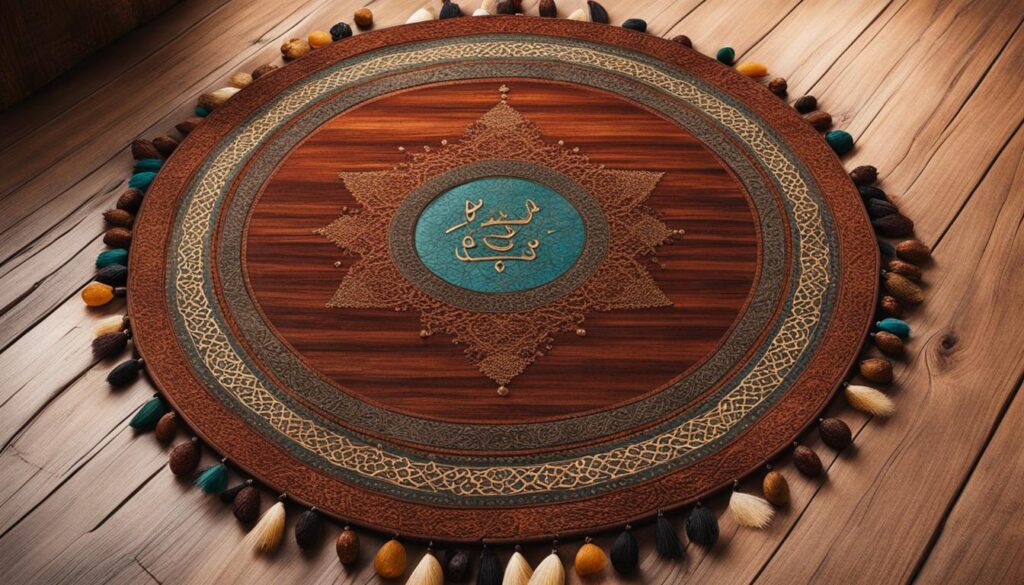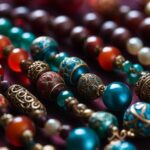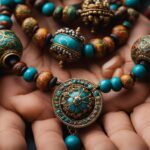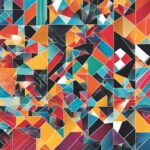The Quran, known as the Islamic holy book, holds profound significance for over a billion Muslims worldwide. It is believed to be the literal word of God, offering guidance and wisdom that transcends religious boundaries. In this article, we will delve into the main prayer tools found in the Quran, their practical usage, symbolic meanings, variations among sects, materials used, changes over time, and unique, lesser-known prayer tools.
Key Takeaways:
- The Quran is a revered religious text that holds universal wisdom and guidance.
- The main prayer tools in the Quran include a prayer mat, prayer beads, a Quranic script, and a compass.
- These tools are used in Muslim worship to create a sacred space and enhance the prayer experience.
- Symbolically, the prayer tools represent purity, devotion, divine revelation, and unity.
- While there may be slight variations among sects, the core rituals and principles of prayer remain consistent.
Main Prayer Tools in the Quran
The Quran, the Islamic holy book, lays the foundation for Muslim prayer rituals, which are key elements of Islamic worship. These rituals involve the use of specific prayer tools that help create a sacred space for Muslims to connect with Allah. The main prayer tools mentioned in the Quran include a prayer mat, misbaha (prayer beads), Quranic script or book, and a compass for determining the direction of prayer (qibla).
The prayer mat, also known as a sajjada, holds great significance in Muslim prayer. It serves as a clean and comfortable surface for Muslims to kneel and prostrate during Salah, the Islamic ritual prayer. The prayer mat is typically made of soft fabric, and its design often includes intricate patterns and symbols associated with Islamic art and culture.
The misbaha, also referred to as tasbih or prayer beads, is another commonly used prayer tool. It consists of a string of beads that Muslims can use to count the repetition of Quranic verses or the 99 names of Allah. This helps individuals maintain focus and concentration during their devotional practices. Misbaha beads can be made from various materials such as wood, semi-precious stones, or plastic.
The Quranic script or book is an essential prayer tool for recitation and reflection. Muslims often recite verses from the Quran, seeking guidance and spiritual enlightenment during their prayers. The Quranic script or book serves as a direct connection to the divine revelation and is treated with utmost respect and reverence. It is typically printed on high-quality paper or showcased in beautifully bound editions.
Lastly, the compass plays a crucial role in determining the qibla, the direction Muslims face during prayer. The qibla points towards the Kaaba in Mecca, the holiest city in Islam. Muslims around the world align their prayers towards this sacred destination. The compass provides a tangible means for individuals to ensure their prayer direction is accurate and in accordance with their faith.
The Main Prayer Tools in the Quran
| Prayer Tool | Usage | Symbolism |
|---|---|---|
| Prayer Mat | Provides a clean and comfortable surface for prayer | Symbolizes the sacredness of prayer and creates a designated space for worship |
| Misbaha (Prayer Beads) | Used for counting Quranic verses or the 99 names of Allah | Symbolizes the repetitive nature of remembrance and devotion |
| Quranic Script or Book | A source of guidance and recitation during prayers | Symbolizes the divine revelation and serves as a guide for reflection |
| Compass | Determines the direction of Mecca for accurate prayer alignment | Symbolizes the unity of Muslims around the world |
These main prayer tools in the Quran are integral to the practice of Muslim prayer rituals. They not only enable individuals to fulfill their religious obligations but also serve as reminders of the sacredness of prayer and the connection between Allah and His worshippers.
Usage of the Prayer Tools in Practice
Prayer tools, as mentioned earlier, play a significant role in the practice of Quranic rituals and Muslim worship. Each tool has a specific purpose and contributes to the overall experience of connecting with Allah. Let’s explore how these prayer tools are used in practice:
Prayer Mat
The prayer mat is an essential tool used for cleanliness and comfort during Salah, the Islamic ritual prayer. Before starting the prayer, Muslims lay the prayer mat on a clean surface, ensuring that it is free from impurities. The mat provides a designated space for individuals to perform their prayers and serves as a physical reminder of the sacredness of the act. It also offers comfort, allowing Muslims to kneel and prostrate without discomfort.
Misbaha (Prayer Beads)
The misbaha, also known as prayer beads, is commonly used for counting recitations during Quranic rituals. Muslims hold the misbaha in their hands and move their fingers along the beads as they repeat specific verses from the Quran or the 99 names of Allah. This repetitive action helps individuals maintain focus, enhance concentration, and engage in deeper spiritual reflection. The misbaha serves as a tool for remembrance and devotion.
“The misbaha is like a spiritual companion during prayer. It guides us through the verses and helps us establish a connection with Allah.”
Quranic Script or Book
The Quranic script or book holds immense significance during prayers. Muslims recite verses from the Quran as an act of devotion and seek guidance from its teachings. The Quran is considered the literal word of Allah, and it offers a source of enlightenment and spiritual nourishment. During prayer, Muslims may read directly from a physical copy of the Quran or recite from memory. The Quranic script or book serves as a guide and a source of inspiration for Muslim worship.
Compass
The compass is used by Muslims to determine the direction of Mecca, the holiest city in Islam, for accurate prayer alignment. Mecca is the direction towards which Muslims face during their daily prayers. By using a compass, individuals ensure they are facing the correct direction, enabling them to align themselves with millions of Muslims around the world who are also engaging in prayer. The compass is a practical tool that helps Muslims maintain unity and consistency in their worship practices.
| Prayer Tool | Usage |
|---|---|
| Prayer Mat | Used for cleanliness and comfort during Salah |
| Misbaha (Prayer Beads) | Used for counting recitations during Quranic rituals |
| Quranic Script or Book | A source of guidance and recitation during prayers |
| Compass | Used to determine the direction of Mecca for accurate prayer alignment |
Symbolic Meanings of the Prayer Tools
In addition to their practical use during prayer, the main prayer tools in the Quran also hold symbolic meanings that deepen the spiritual experience for Muslims. Understanding these symbols can enhance one’s connection to Allah and foster a sense of Islamic spirituality.
Prayer Mat
The prayer mat, also known as a sajjada, holds significant symbolism in Islamic worship. It represents the space where individuals establish a direct connection with Allah. The act of spreading the mat and aligning oneself on it symbolizes the purity and devotion required for prayer. The prayer mat serves as a reminder of the sacredness of prayer and the need for a clean and dedicated space to engage in spiritual communication.
Misbaha
The misbaha, or prayer beads, symbolize the repetitive nature of remembrance and devotion. Each bead represents a verse from the Quran or one of the 99 names of Allah. As Muslims move their fingers across the beads during prayer, they engage in a rhythmic recitation that deepens their connection to the divine. The misbaha serves as a physical reminder of the continuous remembrance of Allah’s attributes and the devotion required in the practice of Islam.
Quranic Script or Book
The Quranic script or book symbolizes the divine revelation and serves as a guide for recitation and reflection during prayer. It represents the direct communication between Allah and the individual, offering guidance, wisdom, and comfort. The physical presence of the Quranic text during prayer serves as a tangible reminder of the spiritual connection to Allah and the importance of seeking His guidance in all aspects of life.
Compass
The compass, used for determining the qibla (direction of Mecca), symbolizes the unity of Muslims around the world. Regardless of their geographical location, all Muslims face the same direction during prayer, emphasizing the sense of community and shared devotion. The compass serves as a visual representation of the global Muslim ummah (community) and the collective spiritual journey towards Allah.
| Prayer Tool | Symbolic Meaning |
|---|---|
| Prayer Mat | Represents a sacred space for direct connection with Allah |
| Misbaha | Symbolizes the repetitive nature of remembrance and devotion |
| Quranic Script or Book | Represents the divine revelation and serves as a guide for recitation and reflection |
| Compass | Symbolizes the unity of Muslims around the world in prayer |
Understanding the symbolic meanings of the prayer tools in the Quran enhances the prayer experience for Muslims. These tools serve as reminders of the sacredness, devotion, and unity that are integral to Islamic spirituality. By incorporating these symbols into their prayers, individuals can deepen their connection to Allah and find spiritual solace in their worship.
Variations Among Sects in Prayer Tools
Within the practice of Islam, there are slight variations among different sects in the usage of prayer tools. These variations primarily stem from cultural traditions and personal preferences. While the core principles and rituals of prayer remain consistent across all sects, some sects may place more emphasis on using specific types of prayer tools.
For example, some sects may prefer using prayer mats made from specific materials or with particular designs. Others may have variations in the design or composition of the misbaha (prayer beads) used for counting recitations of Quranic verses or the names of Allah. These differences in prayer tools reflect the diversity and richness within the Islamic tradition, allowing individuals and communities to express their unique practices while maintaining their connection to the larger Muslim community.
To better understand the variations among sects in prayer tools, let’s take a closer look at Table 5, which highlights some of the differences:
| Prayer Tool | Sect A | Sect B |
|---|---|---|
| Prayer Mat | Preferred material: Cotton | Preferred material: Silk |
| Misbaha | Preferred design: Wooden beads | Preferred design: Semi-precious stones |
| Quranic Script | Preferred edition: Arabic-only | Preferred edition: Arabic-English translation |
Table 5: Variations in Prayer Tools Among Sects
As shown in Table 5, Sect A prefers prayer mats made from cotton, while Sect B prefers silk. Additionally, Sect A uses misbaha with wooden beads, while Sect B prefers misbaha with semi-precious stones. There is also a difference in the preferred edition of the Quranic script, with Sect A favoring Arabic-only editions and Sect B preferring Arabic-English translations.
These variations among sects enrich the Islamic tradition, showcasing the diverse ways in which Muslims engage with prayer tools while maintaining their shared commitment to the core principles and rituals of Muslim worship.
Main Prayer Tools in the Quran
Prayer is an integral part of Islamic worship, and the Quran provides guidance on the main prayer tools used by Muslims. These tools, which include the prayer mat, misbaha (prayer beads), Quranic script or book, and compass, serve important functions in creating a sacred space for worship and enhancing the spiritual experience.
The prayer mat, also known as a sajjadah, is used for cleanliness and comfort during Salah, the Islamic ritual prayer. It provides a designated area for prostration and helps create a sense of focus and reverence. Prayer mats can be made from various materials such as cotton, silk, or synthetic fibers.
The misbaha, or prayer beads, are often used for counting recitations of the Quranic verses or the 99 names of Allah. They serve as a tool for remembrance and devotion. Misbaha can be made from different types of beads, including wooden, plastic, or semi-precious stones.
Table: Materials Used for Prayer Tools
| Prayer Tool | Materials |
|---|---|
| Prayer Mat | Cotton, silk, synthetic fibers |
| Misbaha (Prayer Beads) | Wooden, plastic, semi-precious stones |
| Quranic Script or Book | Paper, high-quality binding materials |
| Compass | Metal, plastic |
The Quranic script or book is a source of guidance and recitation during prayers. It symbolizes the divine revelation and serves as a guide for Muslims in their worship. Quranic scripts or books are usually made from paper or high-quality binding materials to ensure their preservation and respect.
Lastly, the compass is used to determine the direction of Mecca, the holiest city in Islam, for accurate prayer alignment. It symbolizes the unity of Muslims around the world, all facing the same direction in prayer.
These prayer tools, with their respective materials, not only facilitate the physical aspects of prayer but also hold symbolic meanings that enhance the spiritual connection between the worshipper and Allah.

Evolution of Prayer Tools Over Time
The prayer tools used by Muslims have evolved over time, reflecting changes in culture and advancements in material technology. Traditional prayer mats were often handmade and featured intricate designs, but today, they can be found in various styles and patterns. Similarly, misbaha designs have evolved to cater to different aesthetics and personal preferences. The materials used for prayer tools have also changed, with prayer mats now being made from materials such as cotton, silk, or synthetic fibers. Misbaha can be crafted from different types of beads, including wooden, plastic, or semi-precious stones.
One of the significant changes in prayer tools is the inclusion of prayer rugs, which provide a larger area for prostration and are often used in mosques or during special occasions. These rugs are typically larger and more luxurious than regular prayer mats. Additionally, some individuals or sects may use prayer caps during prayer as a sign of humility and respect. These caps are typically made from fabric, such as cotton or wool, and are often embroidered with religious symbols or verses from the Quran.
“The evolution of prayer tools reflects the dynamic nature of Islamic worship, adapting to the changing needs and preferences of the Muslim community.”
While the core principles and rituals of prayer remain consistent across all sects, there may be slight variations in the usage of prayer tools. For example, some sects may place more emphasis on using specific types of prayer mats or misbaha. These variations primarily stem from cultural traditions and personal preferences rather than doctrinal differences. However, the symbolic meanings behind the prayer tools, such as the prayer mat representing purity and the misbaha symbolizing devotion, remain universal.
Unique, Lesser-known Prayer Tools
In addition to the main prayer tools mentioned earlier, there are unique, lesser-known prayer items used by some individuals or sects. These tools add personal and cultural elements to the prayer experience, further enriching the practice of Islamic worship.
One such unique prayer tool is the prayer rug. While prayer mats are commonly used, prayer rugs are larger and often feature intricate designs. They provide a designated space for prayer, adding a sense of sacredness and beauty to the worship experience.
Another lesser-known prayer item is the prayer cap. Worn by some individuals during prayer, it symbolizes humility and reverence in the presence of Allah. The prayer cap is often adorned with intricate embroidery or calligraphy, reflecting cultural traditions.
Conclusion
The Quran, as the Islamic holy book, holds invaluable teachings that guide Muslims in their faith. The prayer tools mentioned in the Quran play a crucial role in Islamic rituals and worship. These tools include the prayer mat, misbaha, Quranic script, and compass, each serving a specific purpose in the practice of Islam.
The prayer mat is used for cleanliness and comfort during Salah, the ritual prayer. It symbolizes the sacred space where individuals establish a direct connection with Allah. The misbaha, or prayer beads, are used for counting recitations of Quranic verses or the names of Allah. They represent the repetitive nature of remembrance and devotion.
The Quranic script or book is a fundamental tool for recitation and reflection during prayer. It symbolizes the divine revelation and serves as a guide for Muslims seeking guidance and spiritual growth. Additionally, the compass is used to determine the direction of Mecca, reflecting the unity of Muslims worldwide in prayer.
While there may be variations among sects in the usage of these prayer tools, the core rituals remain consistent. Materials used for prayer tools vary, with prayer mats made from cotton, silk, or synthetic fibers, and misbaha made from different types of beads. Over time, prayer tools have evolved to incorporate cultural changes and advancements in materials, offering a wide range of styles and patterns.
In addition to the main prayer tools, there are unique, lesser-known prayer items used by some individuals or sects, such as prayer rugs, caps, small Quranic tablets, or fragrances for spiritual purification. These tools add personal and cultural elements to the prayer experience, enriching the spiritual journey of Muslims practicing Islam.
FAQ
What are the main prayer tools mentioned in the Quran?
The main prayer tools mentioned in the Quran are the prayer mat, misbaha (prayer beads), Quranic script or book, and a compass for determining the direction of prayer (qibla).
What is the purpose of the prayer mat?
The prayer mat is used for cleanliness and comfort while performing Salah, the Islamic ritual prayer.
What is the purpose of the misbaha?
The misbaha is often used for counting recitations of the Quranic verses or the 99 names of Allah.
What is the purpose of the Quranic script or book?
The Quranic script or book serves as a source of guidance and recitation during prayers.
What is the purpose of the compass?
The compass is used to determine the direction of Mecca, the holiest city in Islam, for accurate prayer alignment.
What do the prayer mat, misbaha, Quranic script, and compass symbolize?
The prayer mat symbolizes the space where individuals establish a direct connection with Allah. The misbaha symbolizes the repetitive nature of remembrance and devotion. The Quranic script or book symbolizes the divine revelation and serves as a guide for recitation and reflection. The compass symbolizes the unity of Muslims around the world in prayer.
Are there variations in the usage of prayer tools among different Islamic sects?
Yes, there may be slight variations in the usage of prayer tools among different Islamic sects, primarily stemming from cultural traditions and personal preferences.
What materials are prayer tools made from?
Prayer mats can be made from various materials such as cotton, silk, or synthetic fibers. Misbaha can be made from different types of beads, including wooden, plastic, or semi-precious stones. Quranic scripts or books are usually made from paper or high-quality binding materials. Compasses used for determining the qibla direction are typically made of metal or plastic.
How have prayer tools evolved over time?
Prayer tools, such as prayer mats and misbaha, have evolved over time to incorporate cultural changes and advancements in material technology. Traditional prayer mats were often handmade and featured intricate designs, while nowadays, they can be found in various styles and patterns.
Are there any unique, lesser-known prayer tools?
Yes, there are unique, lesser-known prayer tools used by some individuals or sects, such as prayer rugs, prayer caps, small Quranic tablets, or fragrances for spiritual purification.
How do prayer tools enhance the spiritual journey for Muslims?
Understanding and utilizing prayer tools can enhance the spiritual journey for individuals practicing Islam by creating a sacred space for worship, promoting focus and mindfulness during prayer, and adding personal and cultural elements to the prayer experience.









